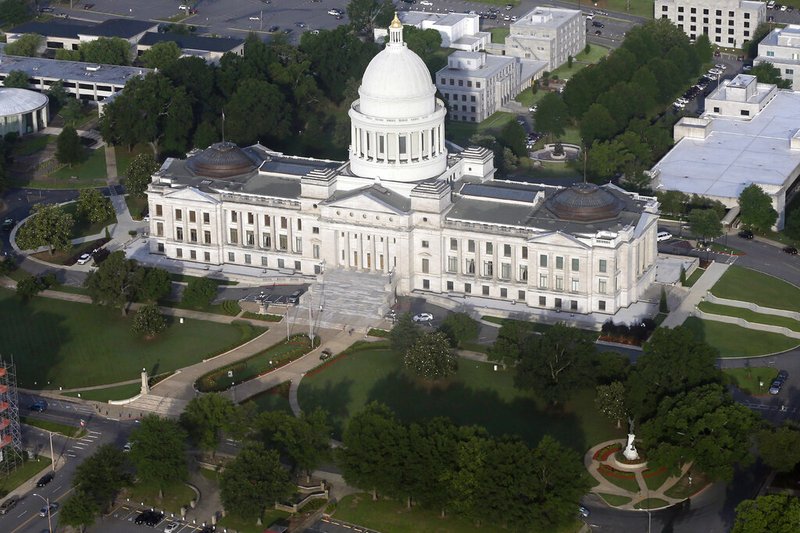Drivers, start your engines: The state is set to consider raising the speed limit on rural interstates to 75 mph.
The Arkansas Highway Commission on Wednesday will consider accepting a study that makes recommendations to increase speeds by 5 mph on rural interstates, urban interstates and other four-lane highways.
The study is the result of Act 784 of 2019, which set the maximum speed on controlled-access highways at 75 mph if the highways are outside urban areas and have at least four lanes divided by a median.
The engineering and traffic study also found it feasible to increase speeds on:
m Urban interstates, to 65 mph from 60 mph.
m Rural multi-lane highways, to 65 mph "unless an engineering study determines the need for a lower speed limit."
The speed limit on other rural highways would remain at 55 mph, "with the option to increase the speed limit to 60 mph on individual highways where an engineering study determines that a higher speed limit is warranted."
The proposed priority routes on which the higher speeds would be allowed include Interstates 40, 30, 49, 55, 555 and 530, as well as U.S. 67.
If the commission adopts the study's recommendations at Wednesday's meeting, then the new speed limits will be in effect on or after July 1.
Existing speed limits would remain in effect until the installation of new signs. Highway Department officials estimate it would take nine weeks to install the new signs. The cost is estimated to be $350,000.
The department and commission are following the dictates of the Arkansas Legislature, which mandated the higher speeds unless an engineering investigation showed them to be unsafe.
"The Legislature established the speed limits," Lorie Tudor, the transportation agency's director, said Monday. "They asked us to identify those roads we should not sign with the speed limits that they established. That was the intent of the study."
Arkansas would join 18 other states that have interstate speeds of at least 75 mph. Six of those states have maximum speeds of 80 mph. One -- Texas -- has a maximum speed of 85 mph. That speed is limited to a 41-mile section of Texas 130 that opened in 2012, according to the Insurance Institute for Highway Safety.
The department's study cited a literature review that found that increasing speed limits also increased the fatality risk in crashes.
According to a 2016 study by the institute, for example, "a 5 mph increase in the maximum state speed limit was associated with an 8 percent increase in fatality rates on Interstates and freeways and a 4 percent increase on other roads," the department study said. "This increase in risk has been so great that it has now largely offset the beneficial effects of some other traffic safety strategies."
But a review of crashes from 1994 to 2015 shows a "declining trend for fatal and serious injury crash rates since 2000, even given the steady increase in the vehicle miles traveled over this period," according to the department study. "It could be argued that technology has played a more significant role in the fluctuation of the rates than the posted speed limit.
"For example, continued improvements in vehicle safety design, airbags, better tires, and the more recent development of collision avoidance systems, have contributed to the declines, whereas the significant rise in the use of smart phones and texting has contributed to the increase."
The study, using the Federal Highway Administration standard of 85th percentile speeds, found that raising the speed limits on selected sections of interstates and other highways was feasible.
The 85th percentile is the speed at which 85% of motorists are at or below and which the federal agency has found is "one of the best indicators of a safe and reasonable speed."
The Manual on Uniform Traffic Control Devices, which is the traffic engineering bible, recommends that agencies set speed limits within 5 mph of the "85th percentile of free-flowing traffic."
"According to FHWA's report, Methods and Practices for Setting Speed Limits ..., motorists who drive faster contribute disproportionately to the risk of crashes," according to an article posted on the Federal Highway Administration's website. "Setting a speed limit 5 [mph] higher than the 85th percentile speed will make a few additional drivers legal, but setting it 5 [mph] lower will make violators out of nearly half of all drivers."
The Arkansas Transportation Department study found that the 85th percentile speed on rural interstates was 71 mph in 2016. The average speed was 52 mph.
The 85th percentile speed on urban interstates was 59 mph. On rural multi-lane highways, it was 67 mph, according to the study.
The different 85th percentile speeds found on rural two-lane highways made it too difficult to establish a uniform higher speed, according to the study, which looked at such routes in two different department districts.
They were District 2, which encompasses Arkansas, Ashley, Chicot, Desha, Drew, Grant, Jefferson and Lincoln counties in southeast Arkansas, and District 9, which encompasses Baxter, Benton, Boone, Carroll, Madison, Marion, Newton and Searcy counties in north Arkansas.
"These Districts were selected to represent the two predominant types of terrain in the state," the study said. "The 85th percentile speed on two-lane highways in District 2 was 65 mph and the 85th percentile speed in District 9, was 60 mph.
"Based on these compared 85th percentile speeds, it would be appropriate for individual speed studies to be performed on rural two-lane highways where increased speed limits are proposed or considered."
